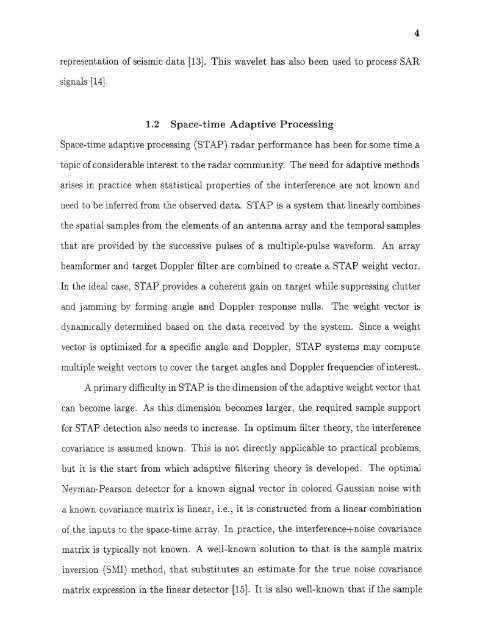Space/time/frequency methods in adaptive radar - New Jersey ...
Space/time/frequency methods in adaptive radar - New Jersey ...
Space/time/frequency methods in adaptive radar - New Jersey ...
Create successful ePaper yourself
Turn your PDF publications into a flip-book with our unique Google optimized e-Paper software.
4representation of seismic data [13]. This wavelet has also been used to process SARsignals [14].1.2 <strong>Space</strong>-<strong>time</strong> Adaptive Process<strong>in</strong>g<strong>Space</strong>-<strong>time</strong> <strong>adaptive</strong> process<strong>in</strong>g (STAP) <strong>radar</strong> performance has been for some <strong>time</strong> atopic of considerable <strong>in</strong>terest to the <strong>radar</strong> community. The need for <strong>adaptive</strong> <strong>methods</strong>arises <strong>in</strong> practice when statistical properties of the <strong>in</strong>terference are not known andneed to be <strong>in</strong>ferred from the observed data. STAP is a system that l<strong>in</strong>early comb<strong>in</strong>esthe spatial samples from the elements of an antenna array and the temporal samplesthat are provided by the successive pulses of a multiple-pulse waveform. An arraybeamformer and target Doppler filter are comb<strong>in</strong>ed to create a STAP weight vector.In the ideal case, STAP provides a coherent ga<strong>in</strong> on target while suppress<strong>in</strong>g clutterand jamm<strong>in</strong>g by form<strong>in</strong>g angle and Doppler response nulls. The weight vector isdynamically determ<strong>in</strong>ed based on the data received by the system. S<strong>in</strong>ce a weightvector is optimized for a specific angle and Doppler, STAP systems may computemultiple weight vectors to cover the target angles and Doppler frequencies of <strong>in</strong>terest.A primary difficulty <strong>in</strong> STAP is the dimension of the <strong>adaptive</strong> weight vector thatcan become large. As this dimension becomes larger, the required sample supportfor STAP detection also needs to <strong>in</strong>crease. In optimum filter theory, the <strong>in</strong>terferencecovariance is assumed known. This is not directly applicable to practical problems,but it is the start from which <strong>adaptive</strong> filter<strong>in</strong>g theory is developed. The optimalNeyman-Pearson detector for a known signal vector <strong>in</strong> colored Gaussian noise witha known covariance matrix is l<strong>in</strong>ear, i.e., it is constructed from a l<strong>in</strong>ear comb<strong>in</strong>ationof the <strong>in</strong>puts to the space-<strong>time</strong> array. In practice, the <strong>in</strong>terference+noise covariancematrix is typically not known. A well-known solution to that is the sample matrix<strong>in</strong>version (SMI) method, that substitutes an estimate for the true noise covariancematrix expression <strong>in</strong> the l<strong>in</strong>ear detector [15]. It is also well-known that if the sample
















